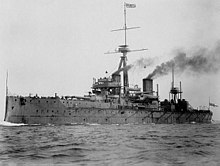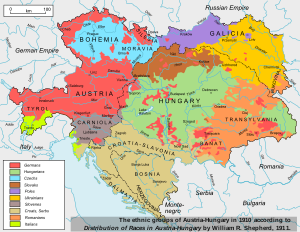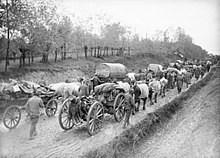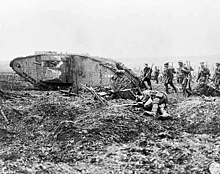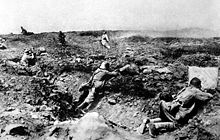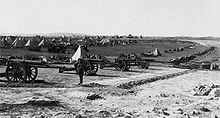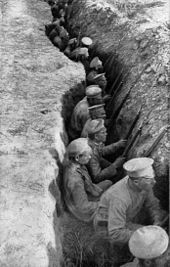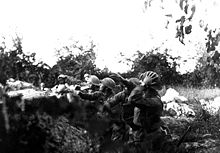World War I
| ||||||||||||||||||||||||||||
| ||||||||||||||||||||||||||||
The term World War One is particularly common in American English, whereas in Britain and the The Commonwealth, it is more commonly called the First World War. This term was first coined in 1920 as the title of Charles à Court Repington's book, but references to it being the first war did not become popular until World War II. The terms World War One and Two were first used in Time magazine in 1938. During and in the aftermath of the conflict it was called the Great War, particularly in British newspapers, whereas US media preferred simply the World War. It was also known as the War to End All Wars.[6]
The assassination on 28 June 1914 of Archduke Franz Ferdinand of Austria, the heir to the throne of Austria-Hungary, is seen as the immediate trigger of the war. Long-term causes, such as imperialistic foreign policies of the great powers of Europe, such as the German Empire, the Austro-Hungarian Empire, the Ottoman Empire, the Russian Empire, the British Empire, France, and Italy, played a major role. Ferdinand's assassination by a Yugoslav nationalist resulted in a Habsburg ultimatum against the Kingdom of Serbia.[7][8] Several alliances formed over the past decades were invoked, so within weeks the major powers were at war; as all had colonies, the conflict soon spread around the world.
On 28 July the conflict opened with the Austro-Hungarian invasion of Serbia,[9][10] followed by the German invasion of Belgium, Luxembourg and France; and a Russian attack against Germany. After the German march on Paris was brought to a halt, the Western Front settled into a static battle of attrition with a trench line that changed little until 1917. In the East, the Russian army successfully fought against the Austro-Hungarian forces but was forced back by the German army. Additional fronts opened after the Ottoman Empire joined the war in 1914, Italy and Bulgaria in 1915 and Romania in 1916. The Russian Empire collapsed in 1917, and Russia left the war after the October Revolution later that year. After a 1918 German offensive along the western front, United States forces entered the trenches and the allies drove back the German armies in a series of successful offensives. Germany agreed to a cease fire on 11 November 1918, later known as Armistice Day.
By the war's end, four major imperial powers—the German, Russian, Austro-Hungarian and Ottoman Empires—had been militarily and politically defeated. The last two ceased to exist.[11] The revolutionized Soviet Union emerged from the Russian Empire, while the map of central Europe was completely redrawn into numerous smaller states.[12] The League of Nations was formed in the hope of preventing another such conflict. The European nationalism spawned by the war and the break-up of empires, and the repercussions of Germany's defeat and the Treaty of Versailles led to the beginning of World War II in 1939.[13]
Contents[show] |
Etymology
Before World War II, the war was also known as The Great War, The World War, The Kaiser's War, The War of the Nations, The War in Europe, or The European War. In the United Kingdom and the United States it was commonly called The war to end war.[14] In France and Belgium it was sometimes referred to as La Guerre du Droit (the War for Justice) or La Guerre Pour la Civilisation / de Oorlog tot de Beschaving (the War to Preserve Civilisation), especially on medals and commemorative monuments. The term used by official histories of the war in Britain and Canada is First World War, while American histories generally use the term World War I.The earliest known use of the term First World War appeared during the war. German biologist and philosopher Ernst Haeckel wrote shortly after the start of the war:
The term was used again near the end of the war. English journalist Charles à Court Repington wrote:There is no doubt that the course and character of the feared "European War" ... will become the first world war in the full sense of the word.[15]—The Indianapolis Star, 20 September 1914
I saw Major Johnstone, the Harvard Professor who is here to lay the bases of an American History. We discussed the right name of the war. I said that we called it now The War, but that this could not last. The Napoleonic War was The Great War. To call it The German War was too much flattery for the Boche. I suggested The World War as a shade better title, and finally we mutually agreed to call it The First World War in order to prevent the millennium folk from forgetting that the history of the world was the history of war.[16]—The First World War, 1914–1918 (1920), Volume I, Page 391.
Background
After 1870, European conflict was averted largely due to a carefully planned network of treaties between the German Empire and the remainder of Europe orchestrated by Chancellor Bismarck. He especially worked to hold Russia at Germany's side to avoid a two-front war with France and Russia. With the ascension of Wilhelm II as German Emperor (Kaiser), Bismarck's system of alliances was gradually de-emphasized. For example, the Kaiser refused to renew the Reinsurance Treaty with Russia in 1890. Two years later the Franco-Russian Alliance was signed to counteract the force of the Triple Alliance. In 1904, the United Kingdom sealed an alliance with France, the Entente cordiale and in 1907, the United Kingdom and Russia signed the Anglo-Russian Convention. This system of interlocking bilateral agreements formed the Triple Entente.[2]
German industrial and economic power had grown greatly after unification and the foundation of the empire in 1870. From the mid-1890s on, the government of Wilhelm II used this base to devote significant economic resources to building up the Imperial German Navy (German: Kaiserliche Marine), established by Admiral Alfred von Tirpitz, in rivalry with the British Royal Navy for world naval supremacy.[18] As a result, both nations strove to out-build each other in terms of capital ships. With the launch of HMS Dreadnought in 1906, the British Empire expanded on its significant advantage over its German rivals.[18] The arms race between Britain and Germany eventually extended to the rest of Europe, with all the major powers devoting their industrial base to the production of the equipment and weapons necessary for a pan-European conflict.[19] Between 1908 and 1913, the military spending of the European powers increased by 50 percent.[20]
Austria-Hungary precipitated the Bosnian crisis of 1908–1909 by officially annexing the former Ottoman territory of Bosnia Herzegovina, which it had occupied since 1878. This greatly angered the Pan-Slavic and thus pro-Serbian Romanov Dynasty who ruled Russia and the Kingdom of Serbia, because Bosnia Herzegovina contained a significant Slavic Serbian population.[21] Russian political maneuvering in the region destabilized peace accords that were already fracturing in what was known as "the Powder keg of Europe".[21]
In 1912 and 1913, the First Balkan War was fought between the Balkan League and the fracturing Ottoman Empire. The resulting Treaty of London further shrank the Ottoman Empire, creating an independent Albanian State while enlarging the territorial holdings of Bulgaria, Serbia, Montenegro and Greece. When Bulgaria attacked both Serbia and Greece on 16 June 1913 it lost most of Macedonia to Serbia and Greece and Southern Dobruja to Romania in the 33 day Second Balkan War, further destabilising the region.[22]
On 28 June 1914, Gavrilo Princip, a Bosnian-Serb student and member of Young Bosnia, assassinated the heir to the Austro-Hungarian throne, Archduke Franz Ferdinand of Austria in Sarajevo, Bosnia.[23] This began a period of diplomatic manoeuvring between Austria-Hungary, Germany, Russia, France and Britain called the July Crisis. Wanting to end Serbian interference in Bosnia conclusively, Austria-Hungary delivered the July Ultimatum to Serbia, a series of ten demands which were intentionally unacceptable, made with the intention of deliberately initiating a war with Serbia.[24] When Serbia acceded to only eight of the ten demands levied against it in the ultimatum, Austria-Hungary declared war on Serbia on 28 July 1914. Strachan argues "Whether an equivocal and early response by Serbia would have made any difference to Austria-Hungary's behaviour must be doubtful. Franz Ferdinand was not the sort of personality who commanded popularity, and his demise did not cast the empire into deepest mourning".[25]
The Russian Empire, unwilling to allow Austria–Hungary to eliminate its influence in the Balkans, and in support of its long time Serb proteges, ordered a partial mobilization one day later.[17] When the German Empire began to mobilize on 30 July 1914, France, sporting significant animosity over the German conquest of Alsace-Lorraine during the Franco-Prussian War, ordered French mobilization on 1 August. Germany declared war on Russia on the same day.[26] The United Kingdom declared war on Germany, on 4 August 1914, following an 'unsatisfactory reply' to the British ultimatum that Belgium must be kept neutral.[27]
Chronology
Opening hostilities
Confusion among the Central Powers
The strategy of the Central Powers suffered from miscommunication. Germany had promised to support Austria-Hungary’s invasion of Serbia, but interpretations of what this meant differed. Previously tested deployment plans had been replaced early in 1914, but never tested in exercises. Austro-Hungarian leaders believed Germany would cover its northern flank against Russia.[28] Germany, however, envisioned Austria-Hungary directing the majority of its troops against Russia, while Germany dealt with France. This confusion forced the Austro-Hungarian Army to divide its forces between the Russian and Serbian fronts.On 9 September 1914, the Septemberprogramm, a possible plan which detailed Germany's specific war aims and the conditions that Germany sought to force upon the Allied Powers, was outlined by German Chancellor Theobald von Bethmann Hollweg. It was never officially adopted.
African campaigns
Serbian campaign
German forces in Belgium and France
In the east, only one Field Army defended East Prussia and when Russia attacked in this region it diverted German forces intended for the Western Front. Germany defeated Russia in a series of battles collectively known as the First Battle of Tannenberg (17 August – 2 September), but this diversion exacerbated problems of insufficient speed of advance from rail-heads not foreseen by the German General Staff. The Central Powers were thereby denied a quick victory and forced to fight a war on two fronts. The German army had fought its way into a good defensive position inside France and had permanently incapacitated 230,000 more French and British troops than it had lost itself. Despite this, communications problems and questionable command decisions cost Germany the chance of obtaining an early victory.[31]
Asia and the Pacific
Early stages
Trench warfare begins
In time, however, technology began to produce new offensive weapons, such as the tank.[35] Britain and France were its primary users; the Germans employed captured Allied tanks and small numbers of their own design.
After the First Battle of the Marne, both Entente and German forces began a series of outflanking manoeuvres, in the so-called "Race to the Sea". Britain and France soon found themselves facing entrenched German forces from Lorraine to Belgium's coast.[7] Britain and France sought to take the offensive, while Germany defended the occupied territories; consequently, German trenches were generally much better constructed than those of their enemy. Anglo-French trenches were only intended to be "temporary" before their forces broke through German defences.[36] Both sides attempted to break the stalemate using scientific and technological advances. On 22 April 1915 at the Second Battle of Ypres, the Germans (in violation of the Hague Convention) used chlorine gas for the first time on the Western Front. Algerian troops retreated when gassed and a six kilometre (four mile) hole opened in the Allied lines that the Germans quickly exploited, taking Kitcheners' Wood. Canadian soldiers closed the breach at the Second Battle of Ypres.[37] At the Third Battle of Ypres, Canadian and ANZAC troops took the village of Passchendaele.

Neither side proved able to deliver a decisive blow for the next two years, though protracted German action at Verdun throughout 1916,[39] combined with the bloodletting at the Somme, brought the exhausted French army to the brink of collapse. Futile attempts at frontal assault came at a high price for both the British and the French poilu (infantry) and led to widespread mutinies, especially during the Nivelle Offensive.[40]
Throughout 1915–17, the British Empire and France suffered more casualties than Germany, due both to the strategic and tactical stances chosen by the sides. At the strategic level, while the Germans only mounted a single main offensive at Verdun, the Allies made several attempts to break through German lines. At the tactical level, Ludendorff's doctrine of "elastic defence" was well suited for trench warfare. This defence had a relatively lightly defended forward position and a more powerful main position farther back beyond artillery range, from which an immediate and powerful counter-offensive could be launched.[41][42]
Ludendorff wrote on the fighting in 1917,
On the battle of the Menin Road Ridge, Ludendorff wrote,The 25th of August concluded the second phase of the Flanders battle. It had cost us heavily ... The costly August battles in Flanders and at Verdun imposed a heavy strain on the Western troops. In spite of all the concrete protection they seemed more or less powerless under the enormous weight of the enemy’s artillery. At some points they no longer displayed the firmness which I, in common with the local commanders, had hoped for. The enemy managed to adapt himself to our method of employing counter attacks ... I myself was being put to a terrible strain. The state of affairs in the West appeared to prevent the execution of our plans elsewhere. Our wastage had been so high as to cause grave misgivings, and had exceeded all expectation.[43]
Another terrific assault was made on our lines on the 20 September ... The enemy’s onslaught on the 20th was successful, which proved the superiority of the attack over the defence. Its strength did not consist in the tanks; we found them inconvenient, but put them out of action all the same. The power of the attack lay in the artillery, and in the fact that ours did not do enough damage to the hostile infantry as they were assembling, and above all, at the actual time of the assault.[44]

In the 1917 Battle of Arras, the only significant British military success was the capture of Vimy Ridge by the Canadian Corps under Sir Arthur Currie and Julian Byng. The assaulting troops were able for the first time to overrun, rapidly reinforce and hold the ridge defending the coal-rich Douai plain.[46][47]
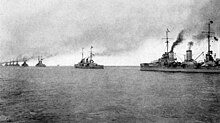
The 1916 Battle of Jutland (German: Skagerrakschlacht, or "Battle of the Skagerrak") developed into the largest naval battle of the war, the only full-scale clash of battleships during the war, and one of the largest in history. It took place on 31 May – 1 June 1916, in the North Sea off Jutland. The Kaiserliche Marine's High Seas Fleet, commanded by Vice Admiral Reinhard Scheer, squared off against the Royal Navy's Grand Fleet, led by Admiral Sir John Jellicoe. The engagement was a stand off, as the Germans, outmanoeuvred by the larger British fleet, managed to escape and inflicted more damage to the British fleet than they received. Strategically, however, the British asserted their control of the sea, and the bulk of the German surface fleet remained confined to port for the duration of the war.[52]
German U-boats attempted to cut the supply lines between North America and Britain.[53] The nature of submarine warfare meant that attacks often came without warning, giving the crews of the merchant ships little hope of survival.[53][54] The United States launched a protest, and Germany modified its rules of engagement. After the notorious sinking of the passenger ship RMS Lusitania in 1915, Germany promised not to target passenger liners, while Britain armed its merchant ships, placing them beyond the protection of the "cruiser rules" which demanded warning and placing crews in "a place of safety" (a standard which lifeboats did not meet).[55] Finally, in early 1917 Germany adopted a policy of unrestricted submarine warfare, realizing the Americans would eventually enter the war.[53][56] Germany sought to strangle Allied sea lanes before the U.S. could transport a large army overseas, but were only able to maintain five long range U-boats on station, to limited effect.[53]
The U-boat threat lessened in 1917, when merchant ships entered convoys escorted by destroyers. This tactic made it difficult for U-boats to find targets, which significantly lessened losses; after the introduction of hydrophone and depth charges, accompanying destroyers might attack a submerged submarine with some hope of success. The convoy system slowed the flow of supplies, since ships had to wait as convoys were assembled. The solution to the delays was an extensive program to build new freighters. Troop ships were too fast for the submarines and did not travel the North Atlantic in convoys.[57] The U-boats had sunk almost 5,000 Allied ships, at a cost of 178 submarines.[58]
World War I also saw the first use of aircraft carriers in combat, with HMS Furious launching Sopwith Camels in a successful raid against the Zeppelin hangars at Tondern in July 1918, as well as blimps for antisubmarine patrol.[59]
Southern theatres
War in the Balkans
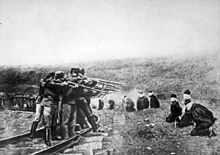
Serbia was conquered in a little more than a month. The attack began in October, when the Central Powers launched an offensive from the north; four days later the Bulgarians joined the attack from the east. The Serbian army, fighting on two fronts and facing certain defeat, retreated into Albania, halting only once to make a stand against the Bulgarians. The Serbs suffered defeat near modern day Gnjilane in the Battle of Kosovo. Montenegro covered the Serbian retreat toward the Adriatic coast in the Battle of Mojkovac in 6–7 January 1916, but ultimately the Austrians conquered Montenegro, too. Serbian forces were evacuated by ship to Greece.[62]
In late 1915, a Franco-British force landed at Salonica in Greece, to offer assistance and to pressure the government to declare war against the Central Powers. Unfortunately for the Allies, the pro-German King Constantine I dismissed the pro-Allied government of Eleftherios Venizelos, before the Allied expeditionary force could arrive.[63]
The Macedonian Front proved static for the most part. Serbian forces retook part of Macedonia by recapturing Bitola on 19 November 1916. Only at the end of the conflict were the Entente powers able to break through, after most of the German and Austro-Hungarian troops had withdrawn. The Bulgarians suffered their only defeat of the war at the Battle of Dobro Pole but days later, they decisively defeated British and Greek forces at the Battle of Doiran, avoiding occupation. Bulgaria signed an armistice on 29 September 1918.[64] Hindenburg and Ludendorff concluded that the strategic and operational balance had now shifted decidedly against the Central Powers and a day after the Bulgarian collapse, during a meeting with government officials, insisted on an immediate peace settlement.[65]
The disappearance of the Macedonian front meant that the road to Budapest and Vienna was now opened for the 670,000-strong army of general Franchet d'Esperey as the Bulgarian capitulation deprived the Central Powers of the 278 infantry battalions and 1,500 guns (the equivalent of some 25 to 30 German divisions) that were previously holding the line.[66] The German high command was able to respond by sending in only seven infantry and one cavalry division but these forces were far from sufficient for a front to be reestablished.[66]
Ottoman Empire
Russian armies generally had the best of it in the Caucasus. Enver Pasha, supreme commander of the Turkish armed forces, was ambitious and dreamed of conquering central Asia. He was, however, a poor commander.[68] He launched an offensive against the Russians in the Caucasus in December 1914 with 100,000 troops; insisting on a frontal attack against mountainous Russian positions in winter, he lost 86% of his force at the Battle of Sarikamish.[69]
General Yudenich, the Russian commander from 1915 to 1916, drove the Turks out of most of the southern Caucasus with a string of victories.[69] In 1917, Russian Grand Duke Nicholas assumed command of the Caucasus front. Nicholas planned a railway from Russian Georgia to the conquered territories, so that fresh supplies could be brought up for a new offensive in 1917. However, in March 1917, (February in the pre-revolutionary Russian calendar), the Czar was overthrown in the February Revolution and the Russian Caucasus Army began to fall apart.

Instigated by the Arab bureau of the British Foreign and Commonwealth Office, the Arab Revolt started with the help of Britain in June 1916 at the Battle of Mecca, led by Sherif Hussein of Mecca, and ended with the Ottoman surrender of Damascus. Fakhri Pasha, the Ottoman commander of Medina, resisted for more than two and half years during the Siege of Medina.[71]
Along the border of Italian Libya and British Egypt, the Senussi tribe, incited and armed by the Turks, waged a small-scale guerrilla war against Allied troops. The British were forced to dispatch 12,000 troops to deal with the Senussi. Their rebellion was finally crushed in mid-1916.[72]
Italian participation
Militarily, the Italians had numerical superiority. This advantage, however, was lost, not only because of the difficult terrain in which fighting took place, but also because of the strategies and tactics employed. Field Marshal Luigi Cadorna, a staunch proponent of the frontal assault, had dreams of breaking into the Slovenian plateau, taking Ljubljana and threatening Vienna. It was a Napoleonic plan, which had no realistic chance of success in an age of barbed wire, machine guns, and indirect artillery fire, combined with hilly and mountainous terrain.
On the Trentino front, the Austro-Hungarians took advantage of the mountainous terrain, which favoured the defender. After an initial strategic retreat, the front remained largely unchanged, while Austrian Kaiserschützen and Standschützen engaged Italian Alpini in bitter hand-to-hand combat throughout the summer. The Austro-Hungarians counter attacked in the Altopiano of Asiago, towards Verona and Padua, in the spring of 1916, (Strafexpedition), but made little progress.
Beginning in 1915, the Italians under Cadorna mounted eleven offensives on the Isonzo front along the Isonzo River, north east of Trieste. All eleven offensives were repelled by the Austro-Hungarians, who held the higher ground. In the summer of 1916, the Italians captured the town of Gorizia. After this minor victory, the front remained static for over a year, despite several Italian offensives. In the autumn of 1917, thanks to the improving situation on the Eastern front, the Austro-Hungarian troops received large numbers of reinforcements, including German Stormtroopers and the elite Alpenkorps. The Central Powers launched a crushing offensive on 26 October 1917, spearheaded by the Germans. They achieved a victory at Caporetto. The Italian army was routed and retreated more than 100 kilometres (60 mi.) to reorganize, stabilising the front at the Piave River. Since in the Battle of Caporetto the Italian Army had heavy losses, the Italian Government called to arms the so-called '99 Boys (Ragazzi del '99), that is, all males who were 18 years old. In 1918, the Austro-Hungarians failed to break through, in a series of battles on the Piave River and, finally being decisively defeated in the Battle of Vittorio Veneto in October of that year. Austria-Hungary surrendered in early November 1918.[74][75]
Romanian participation
In January 1918, Russia, allied to Romania, had to withdraw its troops from the Romanian front and Romanian forces established control over Bessarabia. Although a treaty was signed by the Romanian and the Bolshevik Russian government following talks between 5-9 March 1918 on the withdrawal of Romanian forces from Bessarabia within two months, on 27 March 1918 Romania attached Bessarabia to its territory, formally based on a resolution passed by the local assembly of the territory on the unification with Romania.
Romania officially made peace with the Central Powers signing the Treaty of Bucharest on 7 May 1918. Under that treaty Romania was obliged to cease war with the Central Powers. Romania made small territorial concessions for Austria-Hungary, ceding control of some passes in the Carpathian mountains and granted oil concessions for Germany. On the other hand, the Central Powers recognized the sovereignty of Romania over Bessarabia. The treaty was renounced in October 1918 by the Alexandru Marghiloman government and Romania nominally re-entered the war on 10 November 1918. The next day, the Treaty of Bucharest was nullified by the terms of the Armistice of Compiègne.[76][77] Total Romanian deaths from 1914 to 1918, military and civilian, within contemporary borders, were estimated at 748,000.[78]
The role of India
Eastern Front
Initial actions
Russian Revolution
In March 1917, demonstrations in Petrograd culminated in the abdication of Tsar Nicholas II and the appointment of a weak Provisional Government which shared power with the Petrograd Soviet socialists. This arrangement led to confusion and chaos both at the front and at home. The army became increasingly ineffective.[84]

With the adoption of the Treaty of Brest-Litovsk, the Entente no longer existed. The Allied powers led a small-scale invasion of Russia, partly to stop Germany from exploiting Russian resources and, to a lesser extent, to support the "Whites" (as opposed to "Reds") in the Russian Civil War.[87] Allied troops landed in Archangel and in Vladivostok.
Germany's Kaiser Wilhelm II declares victory
In December 1916, after ten brutal months of the Battle of Verdun, the Germans attempted to negotiate a peace with the Allies, effectively declaring themselves the victors. Soon after, U.S. President Wilson attempted to intervene as a peacemaker, asking in a note for both sides to state their demands. Lloyd George's War Cabinet considered the German offer as a ploy to create divisions amongst the Allies. After initial outrage and much deliberation, they took Wilson's note as a separate effort, signalling that the U.S. was on the verge of entering the war against Germany following the "submarine outrages". While the Allies debated a response to Wilson's offer, the Germans chose to rebuff it in favour of "a direct exchange of views". Learning of the German response, the Allied governments were free to make clear demands in their response of 14 January. They sought restoration of damages, the evacuation of occupied territories, reparations for France, Russia and Roumania, and a recognition of the principle of nationalities. This included the liberation of Italians, Slavs, Roumanians, Czecho-Slovaks, and the creation of a "free and united Poland". On the question of security, the Allies sought guarantees that would prevent or limit future wars, complete with sanctions, as a condition of any peace settlement.[88]1917–1918
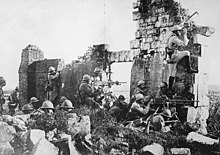
Developments in 1917
Events of 1917 proved decisive in ending the war, although their effects were not fully felt until 1918.The British naval blockade began to have a serious impact on Germany. In response, in February 1917, the German General Staff convinced Chancellor Theobald von Bethmann Hollweg to declare unrestricted submarine warfare, with the goal of starving Britain out of the war. Tonnage sunk rose above 500,000 tons per month from February to July. It peaked at 860,000 tons in April. After July, the newly re-introduced convoy system became extremely effective in reducing the U-boat threat. Britain was safe from starvation and German industrial output fell.
On 3 May 1917, during the Nivelle Offensive, the weary French 2nd Colonial Division, veterans of the Battle of Verdun, refused their orders, arriving drunk and without their weapons. Their officers lacked the means to punish an entire division, and harsh measures were not immediately implemented. Then, mutinies afflicted an additional 54 French divisions and saw 20,000 men desert. The other Allied forces attacked but sustained tremendous casualties.[89] However, appeals to patriotism and duty, as well as mass arrests and trials, encouraged the soldiers to return to defend their trenches, although the French soldiers refused to participate in further offensive action.[90] Robert Nivelle was removed from command by 15 May, replaced by General Philippe Pétain, who suspended bloody large-scale attacks.

In December, the Central Powers signed an armistice with Russia. This released troops for use in the west. Ironically, German troop transfers could have been greater if their territorial acquisitions had not been so dramatic. With German reinforcements and new American troops pouring in, the outcome was to be decided on the Western front. The Central Powers knew that they could not win a protracted war, but they held high hopes for success based on a final quick offensive. Furthermore, the leaders of the Central Powers and the Allies became increasingly fearful of social unrest and revolution in Europe. Thus, both sides urgently sought a decisive victory.[91]
Entry of the United States
Non-Intervention
The United States originally pursued a policy of non-intervention, avoiding conflict while trying to broker a peace. When a German U-boat sank the British liner Lusitania in 1915, with 128 Americans aboard, U.S. President Woodrow Wilson vowed, "America is too proud to fight" and demanded an end to attacks on passenger ships. Germany complied. Wilson unsuccessfully tried to mediate a settlement. He repeatedly warned the U.S. would not tolerate unrestricted submarine warfare, in violation of international law and U.S. ideas of human rights. Wilson was under pressure from former president Theodore Roosevelt, who denounced German acts as "piracy".[92] Wilson's desire to have a seat at negotiations at war's end to advance the League of Nations also played a role.[93] Wilson's Secretary of State, William Jennings Bryan, resigned in protest at what he felt was the President's decidedly warmongering diplomacy. Other factors contributing to the U.S. entry into the war include the suspected German sabotage of Black Tom in Jersey City, New Jersey, and the Kingsland Explosion in what is now Lyndhurst, New Jersey.Making the case
In January 1917, after the Navy pressured the Kaiser, Germany resumed unrestricted submarine warfare. Britain's secret Royal Navy cryptanalytic group, Room 40, had broken the German diplomatic code. They intercepted a proposal from Berlin (the Zimmermann Telegram) to Mexico to join the war as Germany's ally against the United States, should the U.S. join. The proposal suggested that if the U.S. were to enter the war then Mexico should declare war against the United States and enlist Japan as an ally. This would prevent the United States from joining the Allies and deploying troops to Europe, and would give Germany more time for their unrestricted submarine warfare program to strangle Britain's vital war supplies. In return, the Germans would promise Mexico support in reclaiming the territories of Texas, New Mexico, and Arizona that Mexico lost during the Mexican-American War 70 years earlier.[94]U.S. declaration of war on Germany
Crucial to U.S. participation was the sweeping domestic propaganda campaign executed by the Committee on Public Information, overseen by George Creel.[96] The campaign consisted of tens of thousands of government-selected community leaders giving brief carefully scripted pro-war speeches at thousands of public gatherings.[97] Along with other branches of government and private vigilante groups like the American Protective League, it also included the general repression and harassment of people either opposed to American entry into the war or of German heritage.[96] Other forms of propaganda included newsreels, photos, large-print posters, magazine and newspaper articles, and so forth. Additionally, during World War I, Woodrow Wilson placed a great importance on children, especially the Boy Scouts of America, asking them to encourage war support and educate the public about the importance of the war. They helped distribute these war pamphlets, helped sell war bonds, and helped to drive nationalism and support for the war.[98]
First active U.S. participation
The United States was never formally a member of the Allies but became a self-styled "Associated Power". The United States had a small army, but, after the passage of the Selective Service Act, it drafted 2.8 million men[99] and by summer 1918 was sending 10,000 fresh soldiers to France every day. In 1917, the U.S. Congress gave U.S. citizenship to Puerto Ricans when they were drafted to participate in World War I, as part of the Jones Act. Germany had miscalculated, believing it would be many more months before they would arrive and that the arrival could be stopped by U-boats.[100]The United States Navy sent a battleship group to Scapa Flow to join with the British Grand Fleet, destroyers to Queenstown, Ireland and submarines to help guard convoys. Several regiments of U.S. Marines were also dispatched to France. The British and French wanted U.S. units used to reinforce their troops already on the battle lines and not waste scarce shipping on bringing over supplies. The U.S. rejected the first proposition and accepted the second. General John J. Pershing, American Expeditionary Force (AEF) commander, refused to break up U.S. units to be used as reinforcements for British Empire and French units. As an exception, he did allow African-American combat regiments to be used in French divisions. The Harlem Hellfighters fought as part of the French 16th Division, earning a unit Croix de Guerre for their actions at Chateau-Thierry, Belleau Wood and Sechault.[101] AEF doctrine called for the use of frontal assaults, which had long since been discarded by British Empire and French commanders because of the large loss of life.[102]
Austrian offer of separate peace
In 1917, Emperor Charles I of Austria secretly attempted separate peace negotiations with Clemenceau, with his wife's brother Sixtus in Belgium as an intermediary, without the knowledge of Germany. When the negotiations failed, his attempt was revealed to Germany, a diplomatic catastrophe.[103][104]German Spring Offensive of 1918
British and French trenches were penetrated using novel infiltration tactics, also named Hutier tactics, after General Oskar von Hutier. Previously, attacks had been characterized by long artillery bombardments and massed assaults. However, in the Spring Offensive of 1918, Ludendorff used artillery only briefly and infiltrated small groups of infantry at weak points. They attacked command and logistics areas and bypassed points of serious resistance. More heavily armed infantry then destroyed these isolated positions. German success relied greatly on the element of surprise.[106]
The front moved to within 120 kilometers (75 mi) of Paris. Three heavy Krupp railway guns fired 183 shells on the capital, causing many Parisians to flee. The initial offensive was so successful that Kaiser Wilhelm II declared 24 March a national holiday. Many Germans thought victory was near. After heavy fighting, however, the offensive was halted. Lacking tanks or motorised artillery, the Germans were unable to consolidate their gains. This situation was not helped by the supply lines now being stretched as a result of their advance.[107] The sudden stop was also a result of the four Australian Imperial Force (AIF) divisions that were "rushed" down, thus doing what no other army had done and stopping the German advance in its tracks. During that time the first Australian division was hurriedly sent north again to stop the second German breakthrough.
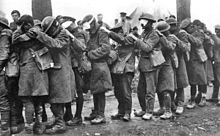
Following Operation Michael, Germany launched Operation Georgette against the northern English channel ports. The Allies halted the drive with limited territorial gains for Germany. The German Army to the south then conducted Operations Blücher and Yorck, broadly towards Paris. Operation Marne was launched on 15 July, attempting to encircle Reims and beginning the Second Battle of the Marne. The resulting counterattack, starting the Hundred Days Offensive, marked their first successful Allied offensive of the war.
By 20 July the Germans were back across the Marne at their Kaiserschlacht starting lines,[109] having achieved nothing. Following this last phase of the war in the West, the German Army never again regained the initiative. German casualties between March and April 1918 were 270,000, including many highly trained stormtroops.
Meanwhile, Germany was falling apart at home. Anti-war marches became frequent and morale in the army fell. Industrial output was 53 percent of 1913 levels.
New states under war zone
In 1918, the internationally recognized Azerbaijan Democratic Republic, Democratic Republic of Armenia and Democratic Republic of Georgia bordering the Ottoman Empire and Russian Empire were established, as well as the unrecognized Centrocaspian Dictatorship and South West Caucasian Republic. Later, these unrecognized states were eliminated by Azerbaijan and Turkey.Allied victory: summer and autumn 1918
The Australian-Canadian spearhead at Amiens, a battle that was the beginning of Germany’s downfall,[44] helped pull the British armies to the north and the French armies to the south forward. While German resistance on the British Fourth Army front at Amiens stiffened, after an advance as far as 14 miles (23 km) and concluded the battle there, the French Third Army lengthened the Amiens front on 10 August, when it was thrown in on the right of the French First Army, and advanced 4 miles (6 km) liberating Lassigny in fighting which lasted until 16 August. South of the French Third Army, General Charles Mangin (The Butcher) drove his French Tenth Army forward at Soissons on 20 August to capture eight thousand prisoners, two hundred guns and the Aisne heights overlooking and menacing the German position north of the Vesle.[114] Another "Black day" as described by Erich Ludendorff.
Meanwhile General Byng of the Third British Army, reporting that the enemy on his front was thinning in a limited withdrawal, was ordered to attack with 200 tanks toward Bapaume, opening the Battle of Albert, with the specific orders of "To break the enemy's front, in order to outflank the enemies present battle front" (opposite the British Fourth Army at Amiens).[44] Allied leaders had now realized that to continue an attack after resistance had hardened was a waste of lives and it was better to turn a line than to try to roll over it. Attacks were being undertaken in quick order to take advantage of the successful advances on the flanks and then broken off when that attack lost its initial impetus.[114]
The British Third Army's 15-mile (24 km) front north of Albert progressed after stalling for a day against the main resistance line to which the enemy had withdrawn.[115] Rawlinson’s Fourth British Army was able to battle its left flank forward between Albert and the Somme straightening the line between the advanced positions of the Third Army and the Amiens front which resulted in recapturing Albert at the same time.[114] On 26 August the British First Army on the left of the Third Army was drawn into the battle extending it northward to beyond Arras. The Canadian Corps already being back in the vanguard of the First Army fought their way from Arras eastward 5 miles (8 km) astride the heavily defended Arras-Cambrai before reaching the outer defences of the Hindenburg line, breaching them on the 28 and 29 August. Bapaume fell on the 29 August to the New Zealand Division of the Third Army and the Australians, still leading the advance of the Fourth Army, were again able to push forward at Amiens to take Peronne and Mont St. Quentin on 31 August. Further south the French First and Third Armies had slowly fought forward while the Tenth Army, who had by now crossed the Ailette and was east of the Chemin des Dames, was now near to the Alberich position of the Hindenburg line.[116] During the last week of August the pressure along a 70-mile (113 km) front against the enemy was heavy and unrelenting. From German accounts, "Each day was spent in bloody fighting against an ever and again on-storming enemy, and nights passed without sleep in retirements to new lines."[114] Even to the north in Flanders the British Second and Fifth Armies during August and September were able to make progress taking prisoners and positions that were previously denied them.[116]

In nearly four weeks of fighting since 8 August, over 100,000 German prisoners were taken, 75,000 by the BEF and the rest by the French. Since "The Black Day of the German Army" the German High Command realized the war was lost and made attempts for a satisfactory end. The day after the battle Ludenforff told Colonel Mertz "We cannot win the war any more, but we must not lose it either." On 11 August he offered his resignation to the Kaiser, who refused it and replied, "I see that we must strike a balance. We have nearly reached the limit of our powers of resistance. The war must be ended." On 13 August at Spa, Hindenburg, Ludendorff, Chancellor and Foreign Minister Hintz agreed that the war could not be ended militarily and on the following day the German Crown Council decided victory in the field was now most improbable. Austria and Hungary warned that they could only continue the war until December and Ludendorff recommended immediate peace negotiations, to which the Kaiser responded by instructing Hintz to seek the Queen of Holland's mediation. Prince Rupprecht warned Prince Max of Baden "Our military situation has deteriorated so rapidly that I no longer believe we can hold out over the winter; it is even possible that a catastrophe will come earlier." On 10 September Hindenburg urged peace moves to Emperor Charles of Austria and Germany appealed to Holland for mediation. On the 14 September Austria sent a note to all belligerents and neutrals suggesting a meeting for peace talks on neutral soil and on 15 September Germany made a peace offer to Belgium. Both peace offers were rejected and on 24 September OHL informed the leaders in Berlin that armistice talks were inevitable.[116]
September saw the Germans continuing to fight strong rear guard actions and launching numerous counter attacks on lost positions, with only a few succeeding and then only temporarily. Contested towns, villages, heights and trenches in the screening positions and outposts of the Hindenburg Line continued to fall to the Allies, with the BEF alone taking 30,441 prisoners in the last week of September. Further small advances eastward would follow the Third Army victory at Ivincourt on 12 September, the Fourth Armies at Epheny on 18 September and the French gain of Essigny-le-Grand a day later. On 24 September a final assault by both the British and French on a 4 mile (6 km) front would come within 2 miles (3 km) of St. Quentin.[116] With the outposts and preliminary defensive lines of the Siegfried and Alberich Positions eliminated the Germans were now completely back in the Hindenburg line. With the Wotan position of that line already breached and the Siegfried position in danger of being turned from the north the time had now come for an assault on the whole length of the line.
The Allied attack on the Hindenburg Line began on 26 September including U.S. soldiers. The still-green American troops suffered problems coping with supply trains for large units on a difficult landscape.[119] The following week cooperating French and American units broke through in Champagne at the Battle of Blanc Mont Ridge, forcing the Germans off the commanding heights, and closing towards the Belgian frontier.[120] The last Belgian town to be liberated before the armistice was Ghent, which the Germans held as a pivot until Allied artillery was brought up.[121][122] The German army had to shorten its front and use the Dutch frontier as an anchor to fight rear-guard actions.
When Bulgaria signed a separate armistice on 29 September, the Allies gained control of Serbia and Greece. Ludendorff, having been under great stress for months, suffered something similar to a breakdown. It was evident that Germany could no longer mount a successful defence.[123][124]
Meanwhile, news of Germany's impending military defeat spread throughout the German armed forces. The threat of mutiny was rife. Admiral Reinhard Scheer and Ludendorff decided to launch a last attempt to restore the "valour" of the German Navy. Knowing the government of Prince Maximilian of Baden would veto any such action, Ludendorff decided not to inform him. Nonetheless, word of the impending assault reached sailors at Kiel. Many rebelled and were arrested, refusing to be part of a naval offensive which they believed to be suicidal. Ludendorff took the blame—the Kaiser dismissed him on 26 October. The collapse of the Balkans meant that Germany was about to lose its main supplies of oil and food. The reserves had been used up, but U.S. troops kept arriving at the rate of 10,000 per day.[125]
Having suffered over 6 million casualties, Germany moved toward peace. Prince Maximilian of Baden took charge of a new government as Chancellor of Germany to negotiate with the Allies. Telegraphic negotiations with President Wilson began immediately, in the vain hope that better terms would be offered than by the British and French. Instead Wilson demanded the abdication of the Kaiser. There was no resistance when the social democrat Philipp Scheidemann on 9 November declared Germany to be a republic. Imperial Germany was dead; a new Germany had been born: the Weimar Republic.[126]
Armistices and capitulations
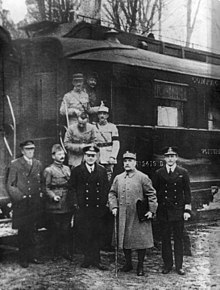
On 24 October the Italians began a push which rapidly recovered territory lost after the Battle of Caporetto. This culminated in the Battle of Vittorio Veneto, which marked the end of the Austro-Hungarian Army as an effective fighting force. The offensive also triggered the disintegration of Austro-Hungarian Empire. During the last week of October declarations of independence were made in Budapest, Prague and Zagreb. On 29 October, the imperial authorities asked Italy for an armistice. But the Italians continued advancing, reaching Trento, Udine and Trieste. On 3 November Austria–Hungary sent a flag of truce to ask for an Armistice. The terms, arranged by telegraph with the Allied Authorities in Paris, were communicated to the Austrian Commander and accepted. The Armistice with Austria was signed in the Villa Giusti, near Padua, on 3 November. Austria and Hungary signed separate armistices following the overthrow of the Habsburg monarchy.
Following the outbreak of the German Revolution, a republic was proclaimed on 9 November. The Kaiser fled to the Netherlands. On 11 November an armistice with Germany was signed in a railroad carriage at Compiègne. At 11 a.m. on 11 November 1918; "the eleventh hour of the eleventh day of the eleventh month"; a ceasefire came into effect. Opposing armies on the Western Front began to withdraw from their positions. Canadian Private George Lawrence Price is traditionally regarded as the last soldier killed in the Great War: he was shot by a German sniper at 10:57 and died at 10:58.[129]
Allied superiority and the stab-in-the-back legend, November 1918
In November 1918 the Allies had ample supplies of men and materiel to invade Germany, yet at the time of the armistice, no Allied soldier had set foot on German soil in anger and Berlin was still almost 900 mi (1,400 km) from the Western Front. The Kaiser's armies had also retreated from the battlefield in good order which enabled Hindenburg and other senior German leaders to spread the story that their armies had not really been defeated. This resulted in the stab-in-the-back legend[130][131] which attributed Germany's losing the war not to its inability to continue fighting (even though up to a million soldiers were suffering from the Spanish Flu and unfit to fight), but to the public's failure to respond to its "patriotic calling" and the intentional sabotaging of the war effort, particularly by Jews, Socialists and Bolsheviks.A formal state of war between the two sides persisted for another seven months, until signing of the Treaty of Versailles with Germany on 28 June 1919. Later treaties with Austria, Hungary, Bulgaria and the Ottoman Empire were signed. However, the latter treaty with the Ottoman Empire was followed by strife (the Turkish Independence War) and a final peace treaty was signed between the Allied Powers and the country that would shortly become the Republic of Turkey, at Lausanne on 24 July 1923.
Some war memorials date the end of the war as being when the Versailles treaty was signed in 1919; by contrast, most commemorations of the war's end concentrate on the armistice of 11 November 1918. Legally the last formal peace treaties were not signed until the Treaty of Lausanne. Under its terms, the Allied forces divested Constantinople on 23 August 1923.
Technology
In 1914, cannons were positioned in the front line and fired directly at their targets. By 1917, indirect fire with guns (as well as mortars and even machine guns) was commonplace, using new techniques for spotting and ranging, notably aircraft and the often overlooked field telephone. Counter-battery missions became commonplace, also, and sound detection was used to locate enemy batteries.
Germany was far ahead of the Allies in utilising heavy indirect fire. She employed 150 and 210 mm howitzers in 1914 when the typical French and British guns were only 75 and 105 mm. The British had a 6 inch (152 mm) howitzer, but it was so heavy it had to be hauled to the field in pieces and assembled. Germans also fielded Austrian 305 mm and 420 mm guns, and already by the beginning of the war had inventories of various calibers of Minenwerfer ideally suited for trench warfare.[134]
Much of the combat involved trench warfare, where hundreds often died for each yard gained. Many of the deadliest battles in history occurred during the First World War. Such battles include Ypres, the Marne, Cambrai, the Somme, Verdun, and Gallipoli. The Haber process of nitrogen fixation was employed to provide the German forces with a constant supply of gunpowder, in the face of British naval blockade.[135] Artillery was responsible for the largest number of casualties[136] and consumed vast quantities of explosives. The large number of head-wounds caused by exploding shells and fragmentation forced the combatant nations to develop the modern steel helmet, led by the French, who introduced the Adrian helmet in 1915. It was quickly followed by the Brodie helmet, worn by British Imperial and U.S. troops, and in 1916 by the distinctive German Stahlhelm, a design, with improvements, still in use today.
The widespread use of chemical warfare was a distinguishing feature of the conflict. Gases used included chlorine, mustard gas and phosgene. Few war casualties were caused by gas,[137] as effective countermeasures to gas attacks were quickly created, such as gas masks. The use of chemical warfare and small-scale strategic bombing were both outlawed by the 1907 Hague Conventions, and both proved to be of limited effectiveness,[138] though they captured the public imagination.[139]
The most powerful land-based weapons were railway guns weighing hundreds of tons apiece. These were nicknamed Big Berthas, even though the namesake was not a railway gun. Germany developed the Paris Gun, able to bombard Paris from over 100 kilometres (60 mi), though shells were relatively light at 94 kilograms (210 lb). While the Allies had railway guns, German models severely out-ranged and out-classed them.
Fixed-wing aircraft were first used militarily by the Italians in Libya 23 October 1911 during the Italo-Turkish War for reconnaissance, soon followed by the dropping of grenades and aerial photography the next year. By 1914 the military utility was obvious. They were initially used for reconnaissance and ground attack. To shoot down enemy planes, anti-aircraft guns and fighter aircraft were developed. Strategic bombers were created, principally by the Germans and British, though the former used Zeppelins as well.[140] Towards the end of the conflict, aircraft carriers were used for the first time, with HMS Furious launching Sopwith Camels in a raid to destroy the Zeppelin hangars at Tondern in 1918.[141]
German U-boats (submarines) were deployed after the war began. Alternating between restricted and unrestricted submarine warfare in the Atlantic, they were employed by the Kaiserliche Marine in a strategy to deprive the British Isles of vital supplies. The deaths of British merchant sailors and the seeming invulnerability of U-boats led to the development of depth charges (1916), hydrophones (passive sonar, 1917), blimps, hunter-killer submarines (HMS R&-1, 1917), forward-throwing anti-submarine weapons, and dipping hydrophones (the latter two both abandoned in 1918).[142] To extend their operations, the Germans proposed supply submarines (1916). Most of these would be forgotten in the interwar period until World War II revived the need.

Manned observation balloons, floating high above the trenches, were used as stationary reconnaissance platforms, reporting enemy movements and directing artillery. Balloons commonly had a crew of two, equipped with parachutes.[143] If there was an enemy air attack, the crew could parachute to safety. At the time, parachutes were too heavy to be used by pilots of aircraft (with their marginal power output) and smaller versions would not be developed until the end of the war; they were also opposed by British leadership, who feared they might promote cowardice.[144] Recognized for their value as observation platforms, balloons were important targets of enemy aircraft.

Another new weapon, flamethrowers, were first used by the German army and later adopted by other forces. Although not of high tactical value, they were a powerful, demoralizing weapon and caused terror on the battlefield. It was a dangerous weapon to wield, as its heavy weight made operators vulnerable targets.
Trench railways evolved to supply the enormous quantities of food, water, and ammunition required to support large numbers of soldiers in areas where conventional transportation systems had been destroyed. Internal combustion engines and improved traction systems for wheeled vehicles eventually rendered trench railways obsolete.
War crimes
Genocide and ethnic cleansing
Ottoman Empire
Russian Empire
Rape of Belgium
Soldiers' experiences

Prisoners of war

Germany held 2.5 million prisoners; Russia held 2.9 million; while Britain and France held about 720,000. Most were captured just prior to the Armistice. The U.S. held 48,000. The most dangerous moment was the act of surrender, when helpless soldiers were sometimes gunned down.[160][161] Once prisoners reached a camp, in general, conditions were satisfactory (and much better than in World War II), thanks in part to the efforts of the International Red Cross and inspections by neutral nations. Conditions were terrible in Russia, starvation was common for prisoners and civilians alike; about 15–20% of the prisoners in Russia died. In Germany food was scarce, but only 5% died.[162][163][164]
The Ottoman Empire often treated POWs poorly.[165] Some 11,800 British Empire soldiers, most of them Indians, became prisoners after the Siege of Kut, in Mesopotamia, in April 1916, 4,250 died in captivity.[166] Although many were in very bad condition when captured, Ottoman officers forced them to march 1,100 kilometres (684 mi) to Anatolia. A survivor said: "we were driven along like beasts, to drop out was to die."[167] The survivors were then forced to build a railway through the Taurus Mountains.
In Russia, where the prisoners from the Czech Legion of the Austro-Hungarian army were released in 1917 they re-armed themselves and briefly became a military and diplomatic force during the Russian Civil War.
While the Allied prisoners of the Central Powers were quickly sent home at the end of active hostilities, the same treatment was not granted to Central Power prisoners of the Allies and Russia, many of which had to serve as forced labor, e.g. in France until 1920. They were only released after many approaches by the ICRC to the Allied Supreme Council.[168] There were still German prisoners being held in Russia as late as 1924.[169]
Military attachés and war correspondents
Military and civilian observers from every major power closely followed the course of the war. Many were able to report on events from a perspective somewhat akin to modern "embedded" positions within the opposing land and naval forces. These military attachés and other observers prepared voluminous first-hand accounts of the war and analytical papers.For example, former U.S. Army Captain Granville Fortescue followed the developments of the Gallipoli campaign from an embedded perspective within the ranks of the Turkish defenders; and his report was passed through Turkish censors before being printed in London and New York.[170] However, this observer's role was abandoned when the U.S. entered the war, as Fortescue immediately re-enlisted, sustaining wounds at Montfaucon d'Argonne in the Meuse-Argonne Offensive, September 1918.[171]
In-depth observer narratives of the war and more narrowly focused professional journal articles were written soon after the war; and these post-war reports conclusively illustrated the battlefield destructiveness of this conflict. This was not the first time the tactics of entrenched positions for infantry defended with machine guns and artillery became vitally important. The Russo-Japanese War had been closely observed by Military attachés, war correspondents and other observers; but, from a 21st Century perspective, it is now apparent that a range of tactical lessons were disregarded or not used in the preparations for war in Europe and throughout the Great War.[172]
Support and opposition to the war
Support
The war was primarily supported by nationalists, industrial producers, and imperialists.In the Balkans, Yugoslav nationalists such as Yugoslav nationalist leader Ante Trumbić in the Balkans strongly supported the war, desiring the freedom of Yugoslavs from Austria-Hungary and other foreign powers and the creation of an independent Yugoslavia.[173] The Yugoslav Committee was formed in Paris on 30 April 1915 but shortly moved its office to London, Trumbić led the Committee.[173]
In the Middle East, Arab nationalism soared in Ottoman territories in response to the rise of Turkish nationalism during the war, with Arab nationalist leaders advocating the creation of a pan-Arab state.[174] In 1916, the Arab Revolt began in Ottoman-controlled territories of the Middle East in an effort to achieve independence.[174]
Italian nationalism was stirred by the outbreak of the war and was initially strongly supported by a variety of political factions. One of the most prominent and popular Italian nationalist supporters of the war was Gabriele d'Annunzio who promoted Italian irredentism and helped sway the Italian public to support intervention in the war.[175] The Italian Liberal Party under the leadership of Paolo Boselli promoted intervention in the war on the side of the Allies and utilized the Dante Aligheri Society to promote Italian nationalism.[176]
A number of socialist parties initially supported the war when it began in August 1914.[177] Initially European socialists became split on national lines with the conception of class conflict held by radical socialists such as Marxists and syndicalists being overstepped by their support for war.[178] Once the war began, Austrian, British, French, German and Russian socialists followed the rising nationalist current by supporting their country's intervention in the war.[179]
Italian socialists were divided on whether to support the war or oppose it, some were militant supporters of the war including Benito Mussolini and Leonida Bissolati.[180] However the Italian Socialist Party decided to oppose the war after anti-militarist protestors had been killed, resulting in a general strike called Red Week.[181] The Italian Socialist Party purged itself of pro-war nationalist members, including Mussolini.[181] Mussolini, a syndicalist who supported the war on grounds of irredentist claims on Italian-populated regions of Austria-Hungary, formed the pro-interventionist Il Popolo d'Italia and the Fasci Riviluzionario d'Azione Internazionalista ("Revolutionary Fasci for International Action") in October 1914 that later developed into the Fasci di Combattimento in 1919 and the origin of fascism.[182] Mussolini's nationalism enabled him to raise funds from Ansaldo (an armaments firm) and other companies to create Il Popolo d'Italia to convince socialists and revolutionaries to support the war.[183]
In April 1918 the Rome Congress of Oppressed Nationalities was held that included Czechoslovak, Italian, Polish, Transylvanian, and Yugoslav representatives that urged the Allies to support national self-determination for the peoples residing within Austria-Hungary.[177]
Opposition

Many countries jailed those who spoke out against the conflict. These included Eugene Debs in the United States and Bertrand Russell in Britain. In the U.S., the 1917 Espionage Act effectively made free speech illegal and many served long prison sentences for statements of fact deemed unpatriotic. The Sedition Act of 1918 made any statements deemed "disloyal" a federal crime. Publications at all critical of the government were removed from circulation by postal censors.[93]
A number of nationalists opposed intervention, particularly within states that the nationalists held hostility to. Irish nationalists staunchly opposed taking part in intervention with the United Kingdom of Great Britain and Ireland.[184] The war had begun amid the Home Rule crisis in Ireland that had begun in 1912 and by 1914 there was a serious possibility of an outbreak of civil war in Ireland between Irish unionists and republicans.[184] Irish nationalists and Marxists attempted to pursue Irish independence, culminating in the Easter Rising of 1916, with Germany sending 20,000 rifles to Ireland in order to stir unrest in the United Kingdom.[184] The UK government placed Ireland under martial law in response to the Easter Rising.[185]
Other opposition came from conscientious objectors – some socialist, some religious – who refused to fight. In Britain 16,000 people asked for conscientious objector status.[186] Many suffered years of prison, including solitary confinement and bread and water diets. Even after the war, in Britain many job advertisements were marked "No conscientious objectors need apply".
The Central Asian Revolt started in the summer of 1916, when the Russian Empire government ended its exemption of Muslims from military service.[187]
In 1917, a series of mutinies in the French army led to dozens of soldiers being executed and many more imprisoned.
In Milan in May 1917, Bolshevik revolutionaries organized and engaged in rioting calling for an end to the war, and managed to close down factories and stop public transportation.[188] The Italian army was forced to enter Milan with tanks and machine guns to face Bolsheviks and anarchists who fought violently until May 23 when the army gained control of the city with almost fifty people killed (three of which were Italian soldiers) and over 800 people arrested.[188]
The Conscription Crisis of 1917 in Canada erupted when conservative Prime Minister Robert Borden brought in compulsory military service over the objection of French-speaking Quebecers.[189] Out of approximately 625,000 Canadians who served, about 60,000 were killed and another 173,000 were wounded.[190]
In 1917, Emperor Charles I of Austria secretly entered into peace negotiations with the Allied powers, with his brother-in-law Sixtus as intermediary, without the knowledge of his ally Germany. He failed, however, because of the resistance of Italy.[191]
In September 1917, the Russian soldiers in France began questioning why they were fighting for the French at all and mutinied.[192] In Russia, opposition to the war led to soldiers also establishing their own revolutionary committees and helped foment the October Revolution of 1917, with the call going up for "bread, land, and peace". The Bolsheviks reached a peace treaty with Germany, the peace of Brest-Litovsk, despite its harsh conditions.
The end of October 1918, in northern Germany, saw the beginning of the German Revolution of 1918–19. Units of the German Navy refused to set sail for a last, large-scale operation in a war which they saw as good as lost, initiating the uprising. The sailors' revolt which then ensued in the naval ports of Wilhelmshaven and Kiel spread across the whole country within days and led to the proclamation of a republic on 9 November 1918 and shortly thereafter to the abdication of Kaiser Wilhelm II.
Conscription
As the war slowly turned into a war of attrition, conscription was implemented in some countries. This issue was particularly explosive in Canada and Australia. In the former it opened a political gap between French-Canadians, who claimed their true loyalty was to Canada and not the British Empire, and the Anglophone majority who saw the war as a duty to both Britain and Canada. Prime Minister Robert Borden pushed through a Military Service Act, provoking the Conscription Crisis of 1917. In Australia, a sustained pro-conscription campaign by Prime Minister Billy Hughes, caused a split in the Australian Labor Party and Hughes formed the Nationalist Party of Australia in 1917 to pursue the matter. Nevertheless, the labour movement, the Catholic Church, and Irish nationalist expatriates successfully opposed Hughes' push, which was rejected in two plebiscites.Conscription put into uniform nearly every physically fit man in Britain, six of ten million eligible. Of these, about 750,000 lost their lives and 1,700,000 were wounded. Most deaths were to young unmarried men; however, 160,000 wives lost husbands and 300,000 children lost fathers.[193]
Aftermath
Health and economic effects

The war had profound economic consequences. Of the 60 million European soldiers who were mobilized from 1914–1918, 8 million were killed, 7 million were permanently disabled, and 15 million were seriously injured. Germany lost 15.1% of its active male population, Austria–Hungary lost 17.1%, and France lost 10.5%.[196] About 750,000 German civilians died from starvation caused by the British blockade during the war.[197] By the end of the war, famine had killed approximately 100,000 people in Lebanon.[198] The best estimates of the death toll from the Russian famine of 1921 run from 5 million to 10 million people.[199] By 1922, there were between 4.5 million and 7 million homeless children in Russia as a result of nearly a decade of devastation from World War I, the Russian Civil War, and the subsequent famine of 1920–1922.[200] Numerous anti-Soviet Russians fled the country after the Revolution; by the 1930s the northern Chinese city of Harbin had 100,000 Russians.[201] Thousands more emigrated to France, England and the United States.

Lobbying by Chaim Weizmann and fear that American Jews would encourage the USA to support Germany culminated in the British government's Balfour Declaration of 1917, endorsing creation of a Jewish homeland in Palestine.[207] A total of more than 1,172,000 Jewish soldiers served in the Allied and Central Power forces in World War I, including 450,000 in Czarist Russia and 275,000 in Austria-Hungary.[208][dead link]
The social disruption and widespread violence of the Revolution of 1917 and the ensuing Russian Civil War sparked more than 2,000 pogroms in the former Russian Empire, mostly in the Ukraine.[209] An estimated 60,000–200,000 civilian Jews were killed in the atrocities.[210]
In the aftermath of World War I, Greece fought against Turkish nationalists led by Mustafa Kemal, a war which resulted in a massive population exchange between the two countries under the Treaty of Lausanne.[211] According to various sources,[212] several hundred thousand Pontic Greeks died during this period.[213]
Peace treaties and national boundaries
After the war, the Paris Peace Conference imposed a series of peace treaties on the Central Powers. The 1919 Treaty of Versailles officially ended the war. Building on Wilson's 14th point, the Treaty of Versailles also brought into being the League of Nations on 28 June 1919.[214][215]In signing the treaty, Germany acknowledged responsibility for the war, agreeing to pay enormous war reparations and award territory to the victors. The "Guilt Thesis" became a controversial explanation of later events among analysts in Britain and the United States. The Treaty of Versailles caused enormous bitterness in Germany, which nationalist movements, especially the Nazis, exploited with a conspiracy theory they called the Dolchstosslegende (Stab-in-the-back legend). The Weimar Republic lost the former colonial possessions and was saddled with accepting blame for the war, as well as paying punitive reparations for it. Unable to pay them with exports (a result of territorial losses and postwar recession),[216] Germany did so by borrowing from the United States. Runaway inflation in the 1920s contributed to the economic collapse of the Weimar Republic and the reparations were suspended in 1931 following the Stock Market Crash in 1929 and the beginnings of the Great Depression worldwide.
Austria–Hungary was partitioned into several successor states, including Austria, Hungary, Czechoslovakia, and Yugoslavia, largely but not entirely along ethnic lines. Transylvania was shifted from Hungary to Greater Romania. The details were contained in the Treaty of Saint-Germain and the Treaty of Trianon. As a result of the Treaty of Trianon, 3.3 million Hungarians came under foreign rule. Although the Hungarians made up 54% of the population of the pre-war Kingdom of Hungary, only 32% of its territory was left to Hungary. Between 1920 and 1924, 354,000 Hungarians fled former Hungarian territories attached to Romania, Czechoslovakia and Yugoslavia.
The Russian Empire, which had withdrawn from the war in 1917 after the October Revolution, lost much of its western frontier as the newly independent nations of Estonia, Finland, Latvia, Lithuania, and Poland were carved from it. Bessarabia was re-attached to the Greater Romania, as it had been a Romanian territory for more than a thousand years.[217]
The Ottoman Empire disintegrated, and much of its non-Anatolian territory was awarded as protectorates of various Allied powers. The Turkish core was reorganized as the Republic of Turkey. The Ottoman Empire was to be partitioned by the Treaty of Sèvres in 1920. This treaty was never ratified by the Sultan and was rejected by the Turkish republican movement, leading to the Turkish Independence War and, ultimately, to the 1923 Treaty of Lausanne.


